
The Caridea, commonly known as caridean shrimp or true shrimp, from the Greek word καρίς, καρίδος, are an infraorder of shrimp within the order Decapoda. This infraorder contains all species of true shrimp. They are found widely around the world in both fresh and salt water. Many other animals with similar names – such as the mud shrimp of Axiidea and the boxer shrimp of Stenopodidea – are not true shrimp, but many have evolved features similar to true shrimp.

The Decapoda or decapods are an order of crustaceans within the class Malacostraca, and includes crabs, lobsters, crayfish, shrimp, and prawns. Most decapods are scavengers. The order is estimated to contain nearly 15,000 extant species in around 2,700 genera, with around 3,300 fossil species. Nearly half of these species are crabs, with the shrimp and Anomura including hermit crabs, porcelain crabs, squat lobsters making up the bulk of the remainder. The earliest fossils of the group date to the Devonian.

The Stenopodidea or boxer shrimps are a small group of decapod crustaceans. Often confused with Caridea shrimp or Dendrobranchiata prawns, they are neither, belonging to their own group.

Amphionides reynaudii is a species of caridean shrimp, whose identity and position in the crustacean system remained enigmatic for a long time. It is a small planktonic crustacean found throughout the world's tropical oceans, which until 2015 was considered the sole representative of the order Amphionidacea, due to unusual morphological features. Molecular data however confirm it as a member of the caridean family Pandalidae, and the confusion of morphology is because only larval phases have so far been studied.

The family Polychelidae contains thirty-eight extant species of blind, benthic lobster-like crustaceans. They are found throughout the world's tropical, sub-tropical and temperate oceans, including the Mediterranean Sea and the Irish Sea.

Hippolytidae is a family of cleaner shrimp, also known as broken-back shrimp or anemone shrimp. The term "broken-back shrimp" also applies to the genus Hippolyte in particular and "cleaner shrimp" is sometimes applied exclusively to Lysmata amboinensis.
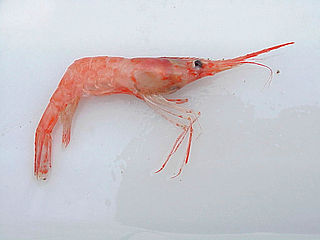
The family Pandalidae is a taxon of caridean shrimp. These species are commonly called pandalid shrimp. They are edible and have high economic value. They are characterised by the subdivided carpus of the second pereiopod and, mainly, by the lack of the chelae (claws) on the first pereiopod. This is a cold-water family, and their representation in tropical areas is made by deep-sea shrimp. The genus Physetocaris, sometimes placed in this family, is now considered to be in its own family, Physetocarididae.
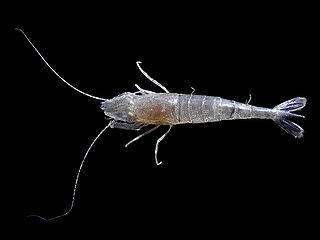
Crangonidae is a family of shrimp, of the superfamily Crangonoidea, including the commercially important species Crangon crangon. Its type genus is Crangon. Crangonid shrimps' first pair of pereiopods have partially chelate claws that they use to capture their prey. They burrow shallowly into sediment on the sea floor, and feed on bivalves, crustaceans, polychaetes, and some small fish.
Physetocaris is a monotypic genus of caridean shrimp, containing a single species, Physetocaris microphthalma.
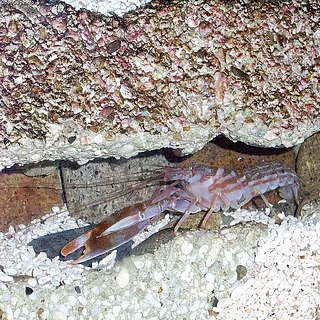
Alpheus is a genus of snapping shrimp of the family Alpheidae. This genus contains in excess of 330 species, making this the most species-rich genus of shrimp. Like other snapping shrimp, the claws of Alpheus are asymmetrical, with one of the claws enlarged for making a popping noise. Some species in the genus enter into symbiotic relationships with gobiid fishes, and others associate with sea anemones.

Munidopsis is a genus of squat lobster. It is the second largest of all the genera of squat lobsters, after Munida, with over 200 species. Its members are mainly found on continental slopes and on abyssal plains. A few fossil species are also known, including specimens from the Campanian (Cretaceous).

Heterocarpus ensifer is a species of deep-water shrimp. The nominate subspecies is found in the Atlantic Ocean from Spain and Madeira to Angola and from North Carolina to the Gulf of Mexico and Caribbean Sea; other subspecies occur in the Pacific Ocean and around the Philippines and Indonesia. Despite being one of the most abundant shrimp in some areas, its biology is still poorly known. These deep water crustaceans are most copious between 300 and 400m. Their distribution demonstrates an ability to adapt well to distinct environments. It is generally found at depths of 200–885 m (656–2,904 ft).

Benthesicymus is a genus of prawns, containing the following species:

Lysmata is a genus of shrimp in the infraorder Caridea, the caridean shrimp. The genus belongs to the family Lysmatidae. Lysmata are popular ornamental shrimp in the marine aquarium trade for their bright color patterns, interesting behaviors, and ability to control certain aquarium pests such as sea anemones of the genus Aiptasia. They are known to command high prices on the pet market.
Birulia is a genus of shrimp in the family Thoridae. It was formerly considered to be part of the family Hippolytidae.
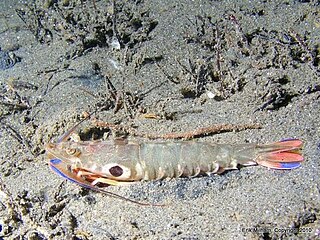
Sicyonia is a genus of prawns, placed in its own family, Sicyoniidae. It differs from other prawns in that the last three pairs of its pleopods are uniramous, rather than biramous as seen in all other prawns.

Trachysalambria is a genus of prawns. It was erected in 1934 by Martin Burkenroad, as a subgenus of Trachypenaeus, with T. curvirostris as its type species. That subgenus was elevated to the rank of genus in 1997 by Isabel Pérez Farfante and Brian Kensley. It contains the following species:
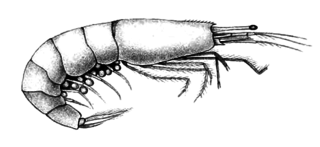
Ogyrides, also known as long eyed shrimps, is a genus of decapod crustaceans consisting of 13 species. It is the only genus in the monotypic family Ogyrididae.

Acanthephyra is a genus of shrimp in the family Acanthephyridae, with species that live at depths from 0 to more than 5000 meters deep below the ocean surface.

Pandalus lucidirimicola, the sparkling shrimp, is a species of caridean shrimp in the family Pandalidae.

















